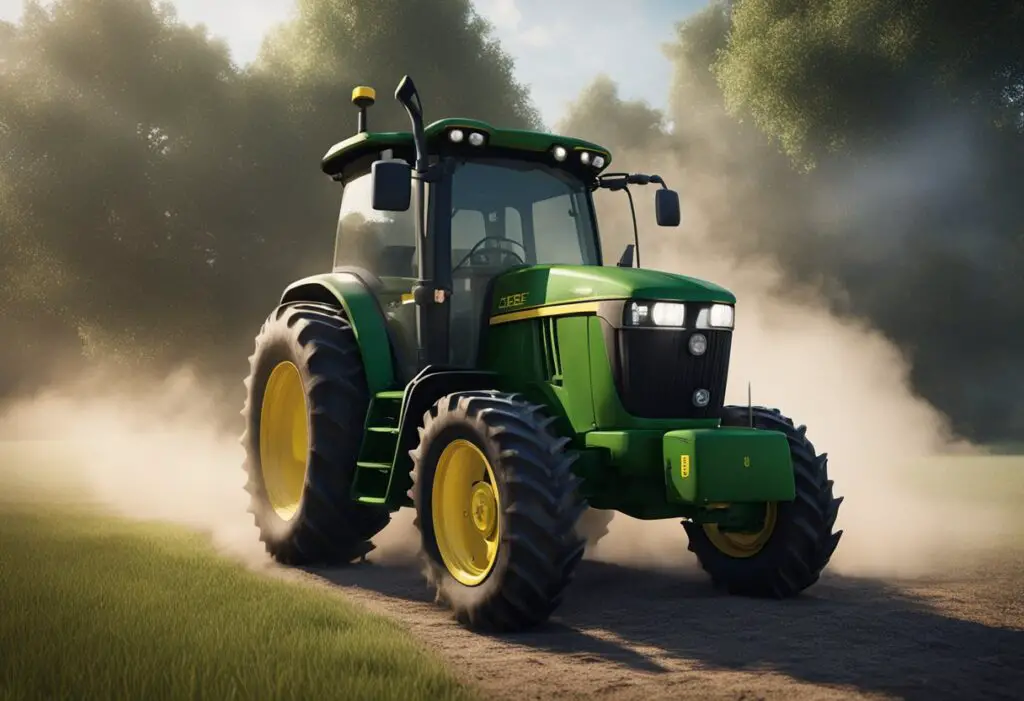This article discusses common 425 John Deere problems and provides troubleshooting tips to help keep your lawn tractor running smoothly. The John Deere 425 is a powerful and reliable lawn tractor, but like any other equipment, it may have problems that need to be addressed. Understanding how to solve these issues can help keep your lawn tractor up and running.

One of the most common John Deere 425 problems is ignition module issues. If the engine is stalling or emitting black smoke, it may be an issue with the ignition module. Another common issue is fuel pump problems, which can cause engine stalling, poor performance, and starting difficulties. Regularly replacing the fuel filter can help prevent these problems. Additionally, a malfunctioning ignition system can cause the engine to cut out, skip, and lose power.
Regular maintenance is also crucial in preventing common John Deere 425 problems. This includes changing the oil and oil filter, checking and replacing the air filter, and inspecting and cleaning the spark plugs. By keeping up with regular maintenance, you can help prevent common problems and keep your lawn tractor running smoothly.
Engine and Starting Issues
John Deere 425 owners have reported several engine and starting issues. These issues can range from fuel system complications to ignition challenges and electrical concerns.
Fuel System Complications
One of the most common engine problems reported by John Deere 425 owners is fuel system complications. This can include issues with the fuel pump, contaminated fuel, or a blocked gas tank cap vent. If the fuel pump fails to operate, the engine will not receive fuel, and the tractor will not start. Contaminated fuel can cause engine misfires, while a blocked gas tank cap vent can cause a vacuum in the fuel tank, preventing fuel flow to the engine.
Ignition Challenges
Ignition challenges are another common issue reported by John Deere 425 owners. This can include problems with the spark plug, ignition module, ignition coil, and high tension leads. If the spark plug is faulty, the engine may not start or may stall during operation. A faulty ignition module can prevent the engine from starting, while a damaged ignition coil can cause engine misfires.
Electrical Concerns
Electrical concerns are also a frequent issue reported by John Deere 425 owners. This can include problems with the battery, starter, solenoid, and voltage regulator. A damaged battery can cause the engine to fail to start, while a faulty starter or solenoid can cause the engine to crank but not start. A faulty voltage regulator can cause the engine to overheat, resulting in engine stalling and poor performance.
Fuel and Airflow System
The fuel and airflow system is critical to the proper functioning of the John Deere 425. Any issues with the fuel or airflow can cause a variety of problems.
Filter and Line Blockages
One common issue with the fuel system is a clogged fuel filter or fuel line. Dirt and debris can accumulate in the fuel filter or line, preventing fuel from flowing properly. This can cause the engine to stall or run poorly. To fix this issue, the fuel filter should be replaced regularly, and the fuel line should be checked for any blockages.
Carburetor and Air Intake
Another common issue is a problem with the carburetor or air intake. The carburetor is responsible for mixing fuel and air in the correct ratio for combustion. If the carburetor is dirty or damaged, it can cause the engine to run poorly or not start at all. The air intake is also important for proper engine function. If the air filter is dirty or clogged, it can restrict airflow and cause the engine to run poorly.
If the engine is emitting black smoke, it may be a sign of a problem with the fuel system. Troubleshooting the fuel system can help identify the issue. It is important to ensure that the fuel being used is not stale, as stale gas can cause problems with the fuel system.
Electrical and Battery Issues

Users have reported several electrical and battery issues with the John Deere 425. These issues include wiring and connection faults, battery and charging system problems, and other electrical issues.
Wiring and Connection Faults
Loose connections, damaged wiring, and other wiring and connection faults can cause electrical problems in the John Deere 425. To diagnose these issues, users can use a digital multimeter to check for voltage drops, shorts, and open circuits in the wiring. The time delay module, ignition system components, spark testers, and other components can also be checked using a digital multimeter.
Battery and Charging System
Battery voltage, charging system components, and other factors can cause charging problems in the John Deere 425. Users can check the voltage regulator, battery, and other charging system components using a digital multimeter and an AC scale. Fused jumper wires, ignition coil wires, and other components can also be checked for grounded or shorted connections.
Conclusion

Experienced with a unique perspective, it is clear that maintaining a John Deere 425 is essential to ensure its durability and reliability. Following the manufacturer’s maintenance schedule can greatly reduce the likelihood of encountering problems with the mower.
Some of the most common problems wi th the John Deere 425 include dirty air filters, fuel line problems, and faulty ignition coils. However, effective solutions are available for these issues. For instance, cleaning the cooling fins and air filter regularly can help prevent clogs and improve the mower’s performance.
In addition to regular maintenance, it is important to address any problems as soon as they arise. Ignoring problems can lead to more serious issues and costly repairs in the future. By taking care of the mower and addressing problems promptly, owners can ensure that their John Deere 425 remains reliable and performs well for years to come.
Frequently Asked Questions
What are common issues with the John Deere 425 garden tractor?
Common problems include overheating, starting issues, power loss during operation, hydraulic leaks, and electrical problems. Some users also report issues with the fuel system and the PTO clutch not engaging properly.
Why does my John Deere 425 overheat?
Overheating can be caused by a clogged cooling system, malfunctioning radiator cap, low coolant levels, or a faulty thermostat. It’s also important to check for debris around the engine and radiator fins.
How can I troubleshoot starting problems on my John Deere 425?
Starting problems may be due to a weak battery, bad connections, a faulty starter solenoid or ignition switch, or a clogged fuel filter. Checking and replacing the spark plugs can also help.
What should I do if my John Deere 425 loses power while mowing?
Power loss can be attributed to a dirty air filter, clogged fuel filter, bad fuel pump, or issues with the carburetor. Ensuring proper maintenance and timely replacement of filters can prevent this.
How do I fix hydraulic leaks in a John Deere 425?
Hydraulic leaks often occur at hose connections or from worn-out seals and gaskets. Identifying the source of the leak and replacing the faulty parts is necessary for repair.
What causes electrical problems in John Deere 425 tractors?
Electrical issues can stem from corroded wires, loose connections, a faulty alternator, or a dead battery. Regular inspection and maintenance of the electrical system can prevent these problems.
Why won’t the PTO clutch on my John Deere 425 engage?
A non-engaging PTO clutch may be due to an electrical fault, such as a bad switch or relay, or it could be a sign of a mechanical failure within the clutch assembly. Checking electrical components and the clutch adjustment can help diagnose the issue.
Leave a Reply